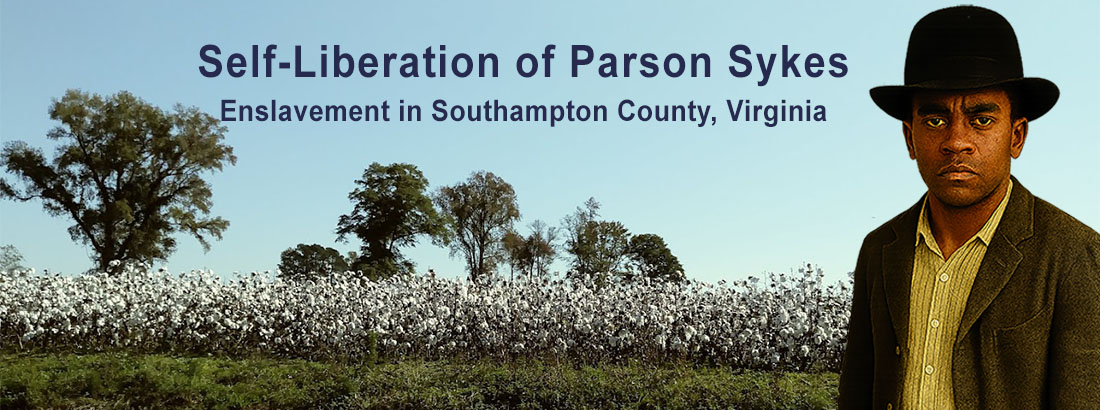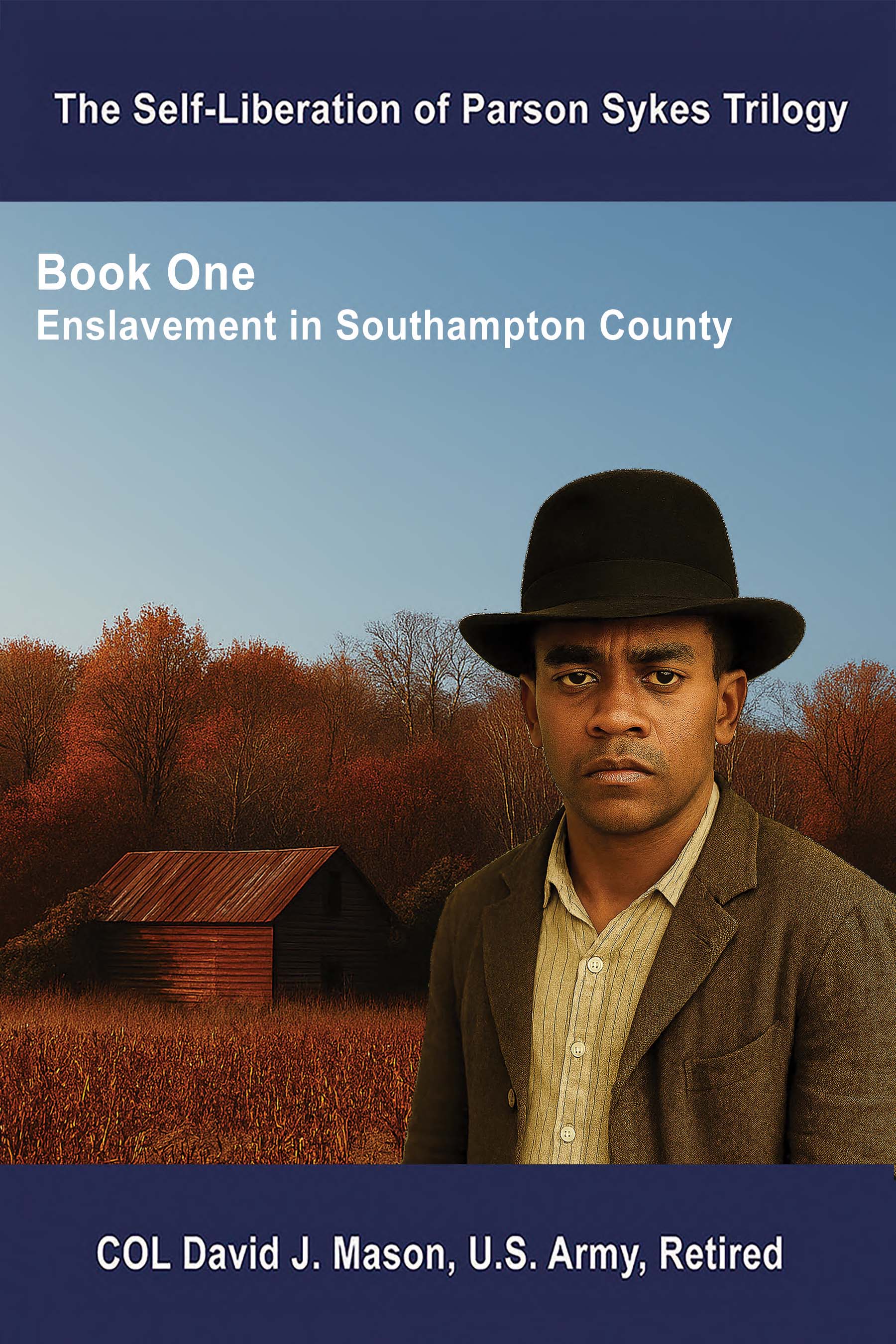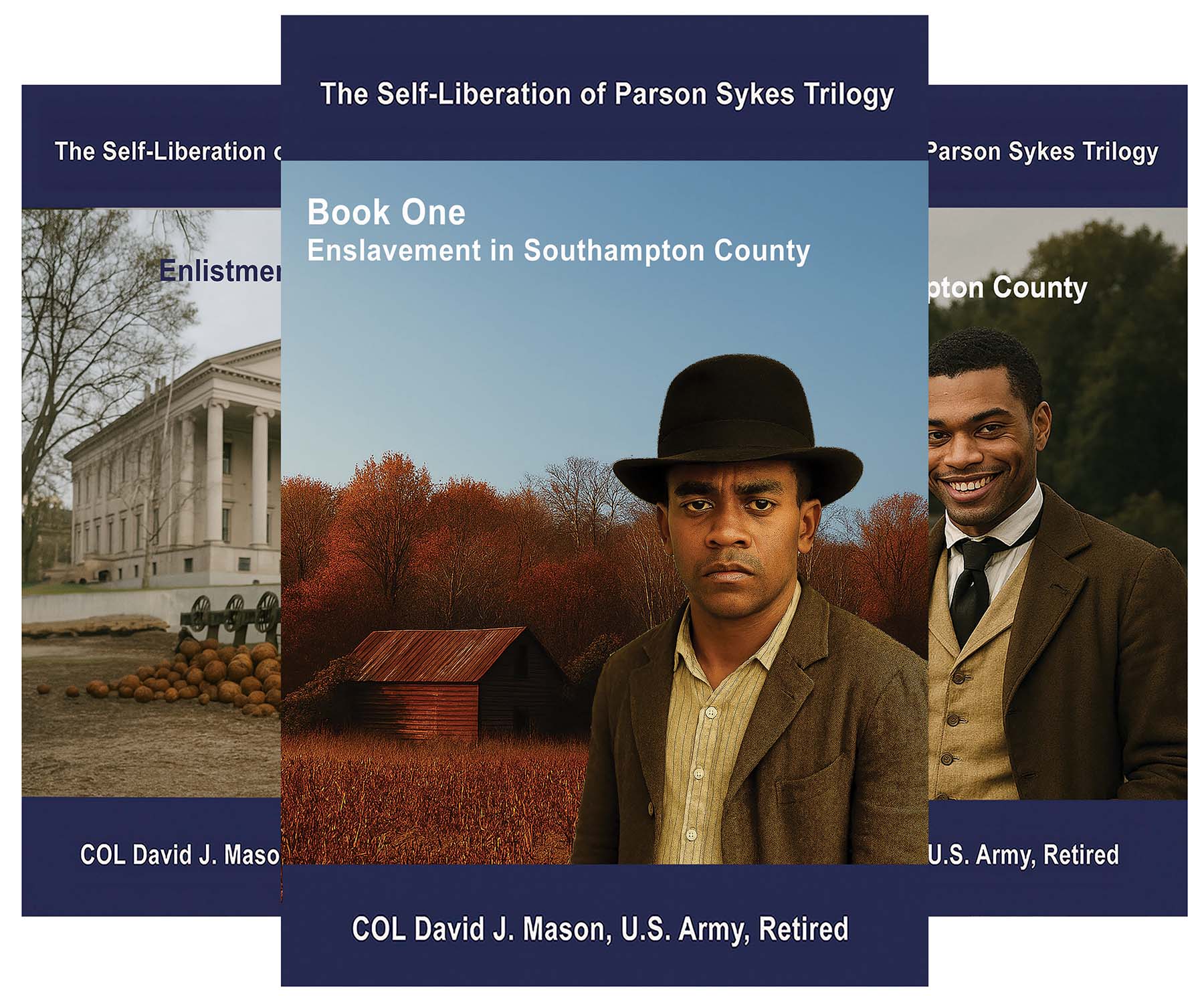
Self-Liberation of Parson Sykes
Enslavement in Southampton County, Virginia
SYNOPSIS
The Self-Liberation of Parson Sykes is the first novel in a trilogy that follows the extraordinary journey of Parson Sykes, an enslaved teenager in Southampton County, Virginia, whose determination to gain freedom leads him to enlist in the Union Army during the closing days of the American Civil War. The story is set on the farm of Jacob Williams, a slaveholder deeply affected by the 1831 Southampton Insurrection led by Nat Turner. This event continues to haunt Jacob and shapes his harsh treatment of those he enslaves, including Parson and his family.
 Parson Sykes was born and raised on Williams’ farm, alongside his parents Solomon Sykes and Louisa Williams, and his brothers Joseph and Henry. The family endures the daily hardships of forced labor in the fields, and Parson is often hired out to the railroad for menial work, which exposes him to new ideas and information. As the Civil War intensifies, Jacob Williams becomes increasingly fearful of losing his enslaved workforce and tightens his control over the plantation. Despite these conditions, Parson’s belief in the injustice of slavery grows stronger, inspired by the abolitionist movement and his own observations of the world around him.
Parson Sykes was born and raised on Williams’ farm, alongside his parents Solomon Sykes and Louisa Williams, and his brothers Joseph and Henry. The family endures the daily hardships of forced labor in the fields, and Parson is often hired out to the railroad for menial work, which exposes him to new ideas and information. As the Civil War intensifies, Jacob Williams becomes increasingly fearful of losing his enslaved workforce and tightens his control over the plantation. Despite these conditions, Parson’s belief in the injustice of slavery grows stronger, inspired by the abolitionist movement and his own observations of the world around him.
Parson and his brothers engage in subtle acts of resistance, such as damaging equipment and working slowly, while maintaining their dignity and faith. Parson’s commitment to self-liberation deepens as he realizes that economic interests and profit sustain slavery for those in power. He becomes determined to break free, not only for himself but as part of a larger struggle for human rights and equality. Parson’s reflections on freedom reveal a universal yearning for autonomy among the Black citizens of Cross Keys, and his encounters with figures like Frances Hill heighten his awareness of the psychological impact of slavery.
Information becomes a crucial tool in Parson’s quest. While working at Boykins Depot, he scavenges discarded broadsides, newspapers, and pamphlets, piecing together news of the war, abolitionist victories, and successful escapes. These scraps of knowledge help him devise a daring plan: to reach Fort Monroe, a Union stronghold, and enlist in the army. Parson meticulously prepares for his escape, gathering supplies, tools, and a railroad map, and strategizing ways to avoid detection by fugitive catchers and hostile locals. He anticipates the dangers of exposure, harsh weather, and unfamiliar terrain, relying on both practical skills and folklore to guide him.
The escape is fraught with peril. Parson, Joseph, and Henry must evade Confederate patrols and vigilantes, risking their lives for a chance at freedom. Their journey is physically and emotionally exhausting, but ultimately successful—they cross into Union-controlled territory, where recruiters at Camp Bowers Hill in Norfolk County welcome them. The brothers enlist in Company I of the First Cavalry Regiment, United States Colored Troops, joining other African American recruits in the fight for liberation.
Beyond Parson’s personal story, the novel highlights the crucial role played by Black soldiers in the Civil War. Through vivid vignettes, it traces the formation and achievements of the Union Army’s XXV Corps, the first all-Black corps to enter the fallen Confederate capital of Richmond. The Self-Liberation of Parson Sykes not only celebrates individual bravery but also honors the collective contributions of those who fought for freedom and justice, offering an essential perspective on America’s history.
![]()
Self-Liberation of Parson Sykes Trilogy
 Step into the untold story of courage, resilience, and freedom. The Self-Liberation of Parson Sykes trilogy brings to life the gripping journey of a young enslaved man who defies oppression, escapes to Union lines, and fights for justice during the Civil War.
Step into the untold story of courage, resilience, and freedom. The Self-Liberation of Parson Sykes trilogy brings to life the gripping journey of a young enslaved man who defies oppression, escapes to Union lines, and fights for justice during the Civil War.
Across three powerful books, you will witness Parson’s transformation—from bondage in Southampton County, to his enlistment in the United States Colored Troops, to his determined stand for civil rights during Reconstruction. This trilogy is not just historical fiction—it is a deeply human narrative that illuminates the fight for equality and the enduring spirit of self-liberation. If you are ready to experience a story that blends history, heart, and heroism, don’t wait—discover the trilogy today on Amazon.
The Self-Liberation of Parson Syke Trilogy tells a powerful and inspiring saga centered on one man's unwavering fight for justice and equality. It cites historical political events that abetted Parson’s self-liberation in a compelling narrative, ensuring readers understand the accuracy and reliability of the information presented. This saga profiles Parson’s continued ordeal to earn freedom, citizenship, equality, and to own land after serving honorably as a soldier of the USCT. Hopefully, this true story will give readers a deeper understanding of the complex challenges that formerly enslaved Black people faced before, during, and after the Civil War.
Add The Self-Liberation of Parson Sykes to your Kindle or bookshelf now and join readers uncovering one of the most compelling Civil War journeys ever told.

